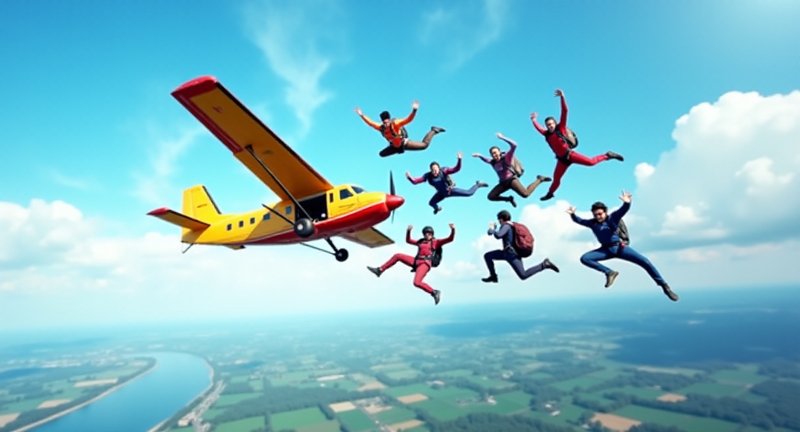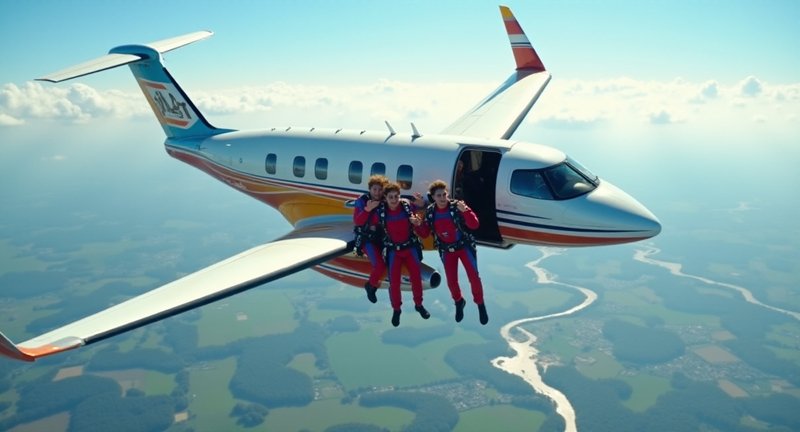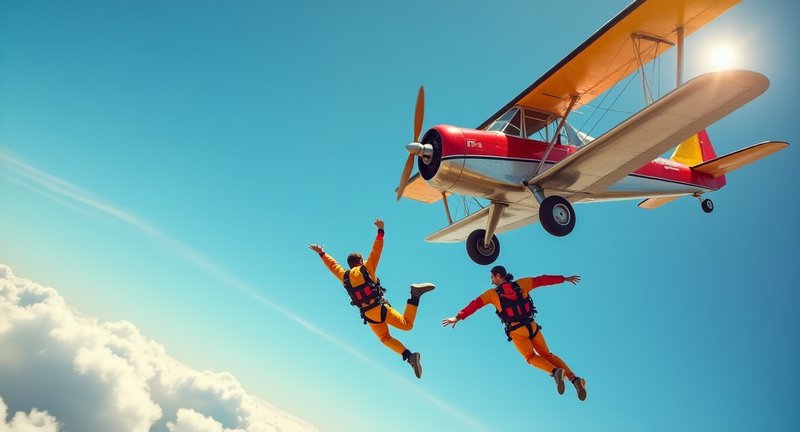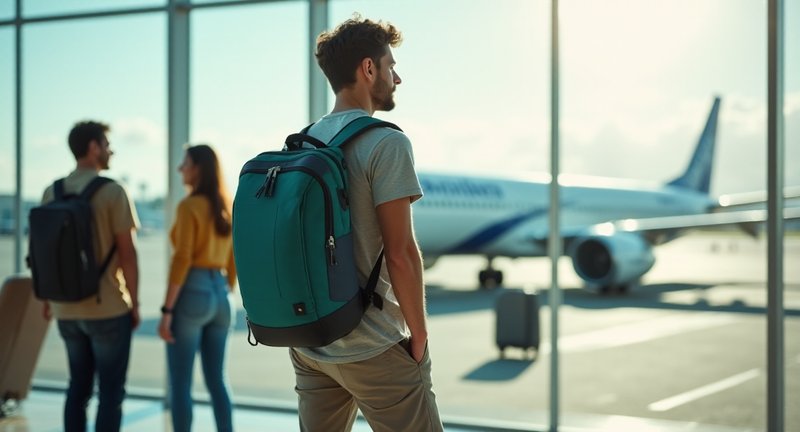Guide to Airplane for Skydiving
When you think of skydiving, your first image might be of the jump, but let me tell you the magic starts with the airplane for skydiving. It’s not just a tool to get you to altitude, it’s part of the whole adrenaline-fueled experience. Unlike your average commercial flight, these planes are designed to give you a heart-pumping thrill even before you leap out the door.

Here are a few key things to know about these unique aircraft:
-
Compact and Efficient: The skydive-ready aircraft is often smaller than commercial planes, making it agile and quick to ascend. Some of the most common models are the Cessna 182, PAC 750XL, and Twin Otter. These planes are light, built for short takeoffs, and perfect for that swift climb to the sky.
-
Modified for Adventure: Inside, they’re stripped down. Don’t expect cushy seats or in-flight entertainment. You’ll find benches or simple seating arrangements that leave plenty of room for jump gear and people. The doors? Larger and designed for quick, easy exits exactly what you need when you’re about to take the plunge.
-
Altitude Matters: The jump plane climbs up to anywhere between 10,000 and 15,000 feet, depending on the drop zone. The higher the altitude, the longer the freefall. And trust me, when you’re sitting on that bench watching the earth grow smaller beneath you, every second of ascent builds your anticipation.
So, the next time you’re gearing up for a jump, don’t just think of the plane as a means to an end. That freefall aircraft is your partner in adventure, setting the stage for the ultimate thrill ride.
Choosing the Best Airplane for Skydiving
As it relates to selecting the right aircraft for a skydiving adventure, there are a few things I’ve learned along the way. I’ve had the thrill of jumping from different types of planes, and believe me, each one brings a unique experience to the dive.
First off, consider the type of jump you’re planning. Are you a first-timer taking a tandem jump, or are you ready for some solo freefall action? Some aircraft are better suited for certain jumps. For instance:
- Cessna 182: A reliable workhorse for smaller groups, it’s perfect for scenic climbs at a slower pace. Great for those who appreciate a bit of anticipation.
- Twin Otter: Now, if you’re looking for volume, the Twin Otter can handle larger groups and get you to altitude faster. It’s ideal for busy drop zones.
- Skyvan: Ever felt like you were walking out of a moving van in the sky? The Skyvan’s rear exit ramp makes for an epic departure, whether you’re belly-flopping into the wind or striking a pose for that first breath of freefall.
But it’s not just about the type of plane. Think about the location and altitude. Certain planes excel at climbing to higher altitudes for that longer freefall, while others are better for shorter jumps closer to the ground. I remember once jumping from a Pilatus Porter fast ascent, minimal wait time. Perfect for those who just can’t wait to leap!

Keep these details in mind when planning your next jump, and you’ll not only enjoy the fall but the ride up as well.
Introduction to Skydiving Aircraft
Stepping into the world of skydiving starts long before the freefall. The moment you board the craft, you can feel the energy crackle. These planes are not your typical flying machines they’re built to climb fast and take you straight into the adventure. They may be small, but don’t be fooled by their size; they carry big adrenaline.
When you sit inside, the roar of the engines drowns out almost every other thought. There’s a raw, industrial feel to the cabin, with benches where seats might otherwise be. It’s a unique setup, designed for one thing: to get us sky-bound, quickly and efficiently.
I’ve been in a variety of these flying contraptions, from the vintage models to modern beasts. Each has its own personality. You notice how some shudder slightly as they ascend, while others slice through the air like an arrow. Every second spent rising in altitude is a buildup of anticipation.
There’s no in-flight service here, no frills just you, the jump crew, and that all-important open door. The moment that door slides open, the world outside takes on an entirely new meaning. The craft becomes a gateway to the extraordinary, and suddenly, the ground feels very far away.
For anyone gearing up for their first jump, it’s important to remember this: the aircraft isn’t just a vehicle; it’s part of the experience. It frames the entire journey from the ground to that first breathtaking leap into the sky.
Factors to Consider When Choosing a Jump Plane
Choosing the right jump plane is a thrilling adventure in itself. Picture this: you’re soaring through the clouds, anticipation bubbling inside you, and that moment is partly shaped by the craft you’re in.
First off, consider the aircraft’s capacity. A spacious cabin means more friends can join in on the fun. It’s about the camaraderie, right? Trust me, sharing that adrenaline rush with pals makes the experience unforgettable.
Next, the altitude capabilities of your chosen aircraft play a crucial role. If you’re aiming for higher jumps, you’ll want a plane that can reach those dizzying heights with ease. I remember my first jump; feeling like a bird as we ascended higher than I thought possible it was pure magic.
Then, let’s talk about the performance. The aircraft’s reliability is non-negotiable. I’ve been in planes that felt like a second home, sturdy and dependable. You want a machine that instills confidence, allowing you to focus on the leap rather than the mechanics of the flight.
Don’t forget about the crew! A knowledgeable and friendly staff can make or break your experience. I cherish those moments when the pilot shares tales of the skies. It’s like being part of an exclusive club that understands the thrill of flight.
As a matter of fact, think about the location. Different jump spots offer unique views and vibes. A plane that can navigate to your dream drop zone opens up a world of possibilities.
So, when selecting a jump plane, remember these elements to elevate your skydiving journey to new heights.
Types of Aircraft Used for Skydiving
When I first embarked on my skydiving journey, I was curious about the metallic birds that would carry us to the skies. It’s fascinating to see how different types of aircraft serve this exhilarating sport, each with its own charm and purpose.
From the robust Cessna 172 to the nimble De Havilland DHC-6 Twin Otter, these flying machines have a lot in common: they take you higher, closer to that thrilling leap into the open sky. I remember the first time I boarded a Cessna; its compactness gave me a sense of intimacy with my fellow adventurers, creating an instant camaraderie before the plunge.
For larger groups, the Twin Otter is a favorite among skydiving enthusiasts. It’s spacious and has a remarkable capacity to accommodate multiple jumpers. I found it exhilarating to see friends gearing up, their excitement palpable, all while the engine roared to life.
Then there’s the Pilatus PC-12, a Swiss wonder with sleek lines and a powerful presence. Riding in one of these beauties felt like being cradled in luxury as we climbed higher, the horizon stretching endlessly before us. The views alone make the ascent worth it.
And let’s not forget about some of the more unconventional options, like the vintage WWII planes. There’s something nostalgic and thrilling about jumping from an aircraft steeped in history, as it adds a layer of adventure to the experience. Each type of aircraft contributes its unique flair to the skydiving adventure, enhancing the thrill of freefalling into the great unknown.
Performance Requirements for Skydiving Planes
Considering the thrill of freefalling through the skies, the aircraft taking you there needs to be a true champion. From my own experiences, I’ve learned that not all flying machines are cut from the same cloth when it comes to skyward adventures.
First off, speed is of the essence. A plane that zips up to altitude with a quickness can make all the difference. There’s something exhilarating about feeling the ascent as you inch closer to the moment of liberation. The right aircraft should have a sprightly spirit, ready to lift its passengers high without unnecessary delay.
Next, let’s talk about capacity. It’s not just about taking off; it’s about how many brave souls can join you in the leap. A spacious cabin can transform a nervous bunch into a band of bold adventurers, all united by a shared purpose. I’ve felt the camaraderie grow as we gear up together, and a larger aircraft allows for a more vibrant atmosphere.
And we can’t ignore stability. The journey to the jump zone should be as smooth as a cloud’s embrace. A sturdy craft not only enhances safety but also fosters a sense of confidence. You want to feel secure and ready when that door opens, and the ground seems to whisper your name.
As a matter of fact, consider the power of reliability. You want a machine that won’t falter when it matters most. I’ve always trusted those with a solid track record, as the stakes are high, and so are our dreams of soaring through the heavens. So, when choosing the chariot of your aerial escapade, remember these performance requirements they can turn a good day into an unforgettable one.
Capacity: How Many Jumpers Can the Aircraft Carry?
In relation to exhilarating leaps from the sky, the capacity of the aircraft is a pivotal consideration. I remember my first jump, the anticipation building as I envisioned the thrilling experience ahead. The aircraft’s capacity can make or break a group’s adventure, and trust me, it’s worth knowing just how many jumpers can comfortably ride along.
Imagine a bustling aircraft, packed with eager adventurers, all buzzing with excitement. Each jump brings a unique energy, and a well-filled cabin creates a contagious atmosphere. However, it’s crucial to balance that enthusiasm with safety and comfort. Overcrowding can lead to a cramped environment, making the whole experience less enjoyable.
The typical capacity can vary significantly depending on the model. Some can accommodate a handful of jumpers, while others can hold a larger crew ready to take the plunge. It’s fascinating how different designs cater to various group sizes, and the choice ultimately influences the vibe of the dive.
You’ll want to consider the weight distribution too. Proper placement ensures stability during flight, allowing for a smooth ascent and a controlled descent. I always find myself peeking out the windows, watching the world shrink beneath me, and knowing that everyone aboard shares that magical moment.
So, whether you’re planning a solo jump or rallying a group of thrill-seekers, understanding the aircraft’s capacity is essential. The right fit can transform a simple jump into an unforgettable adventure shared with friends.
Airplane for Skydiving: A Deep Dive into the Essentials
When you think about the experience of leaping from the sky, the aircraft that takes you there becomes more than just a mode of transport; it transforms into a vital part of the adventure. Let me take you on a thrilling journey into the essential elements of these flying machines that facilitate our lofty pursuits.

First and foremost, choosing the right aircraft is crucial. Each type serves unique purposes and comes with its quirks:
- Cessna 172: A reliable classic. Perfect for beginners, it offers a stable ride as you ascend to your jump altitude.
- Twin Otter: This beauty can hold a larger group, making it ideal for those adrenaline-packed group jumps.
- Skyvan: A boxy marvel that maximizes space, allowing for easy entry and exit a favorite among seasoned jumpers.
Then there’s the elevation factor. Typically, skydivers jump from altitudes ranging from 10,000 to 15,000 feet. But some thrill-seekers crave more:
- Altitude 18,000 feet: A breathtaking view, but ensure you have the right gear and oxygen supply.
- Cloud surfing: Ever considered jumping through clouds? A surreal experience that requires precision timing and skill.
As I’ve learned from my own escapades, the atmospheric conditions can make or break your adventure. Always check:
- Wind Speed: Too strong, and you might end up doing an unplanned landing.
- Visibility: Clear skies are your best friends.
Before you leap, remember the vibe of the aircraft. A cramped space can create anxiety, while a spacious, welcoming environment fosters camaraderie among jumpers. So, embrace the thrill, breathe in the anticipation, and let the aircraft be your trusty steed as you embark on this exhilarating adventure.
Climb Rate and Altitude Capabilities
When I think about the exhilarating experience of jumping from an airplane, the climb rate and altitude capabilities of the aircraft come rushing to mind. The perfect airplane for skydiving isn’t just any flying machine; it’s a carefully selected vessel designed for adventure, offering both safety and excitement.
A plane’s climb rate is crucial for skydivers. The faster the ascent, the quicker you’ll reach those breathtaking heights. Imagine the anticipation as you climb higher and higher, the ground below shrinking into a patchwork of colors.
Altitude capabilities also play a pivotal role in the skydiving experience. Most skydiving flights reach between 10,000 and 15,000 feet, but some adventurous souls dare to ascend even further. At these heights, the view transforms into a breathtaking panorama that makes every nerve-racking second worth it.
I’ve always marveled at the transformation that occurs as the plane reaches the jump altitude. There’s a moment of collective silence among the divers, a pause that feels almost sacred before the chaos of freefall ensues. Trust me; it’s an unforgettable prelude to the thrill that follows.
Remember, the aircraft for parachuting must be equipped to handle the unique demands of this exhilarating sport. Whether it’s the reliable Cessna 172 or the robust Twin Otter, each aircraft is crafted to deliver a smooth and safe ride for those looking to embrace the sky.
So, if you’re considering your first leap into the unknown, pay attention to the airplane you’ll be boarding. After all, it’s the key to unlocking a world of adventure that awaits you in the clouds.
Cost of Operating Skydiving Aircraft
Operating skydiving aircraft is a fascinating endeavor, but it doesn’t come without its financial intricacies. When I first dipped my toes into the skydiving world, I quickly discovered that the costs associated with keeping these flying machines aloft are as varied as the clouds they glide through.
Fuel is often the first beast to tackle. Just like a car guzzles gas, these aircraft consume fuel at an astonishing rate. The price can fluctuate based on the ever-changing market, which means budgeting for flights requires a keen eye on those numbers.
Maintenance costs can feel like a never-ending treadmill. Regular inspections, repairs, and parts replacements are essential to keep these flying wonders safe. From minor checks to overhauls, the upkeep is crucial, ensuring every jump is as safe as a cozy blanket on a chilly night.
Insurance is another layer in this cake of expenses. It’s vital to protect not just the aircraft but also the brave souls who leap from it. The right policy can feel like a financial fortress, safeguarding against potential mishaps.
And then there’s the labor of love staff wages. The folks who work on the ground and in the air are the heart of the operation. From pilots to ground crew, their expertise is priceless, yet it all adds up at the end of the month.
In my experience, understanding these costs is pivotal. Every penny spent is an investment in the exhilaration of freefall and the stunning views that come with it. So, if you’re considering this adventure, keep a close watch on your finances, and you’ll soar through the skies without a worry.
Popular Aircraft Models for Skydiving
With a focus on experiencing the exhilarating rush of freefalling from the sky, the aircraft that whisk you up to the heavens play a pivotal role in the adventure. Over the years, I’ve had the chance to leap from several aircraft models, each with its unique charm and quirks. Let me share some of the popular models that skydivers often rely on, and you might just find yourself daydreaming about your next jump!
Notable Aircraft Models for Skydiving
-
Cessna 172: This classic four-seater has become a staple in the skydiving world. It’s reliable, easy to fly, and provides a smooth ride up to altitude. The panoramic views from the open door make the anticipation of jumping even more thrilling!
-
Piper Super Cub: Known for its short takeoff and landing capabilities, this nimble aircraft is perfect for jumpers who enjoy a more intimate setting. Its open cockpit design offers a unique experience, allowing you to feel the wind before you take the plunge.
-
DHC-6 Twin Otter: With a focus on group jumps, the Twin Otter shines. With ample space for jumpers and gear, it can accommodate larger loads and climb quickly to altitude. Plus, its sturdy build means you’ll feel secure while gearing up for your leap.
-
Pilatus PC-12: This sleek single-engine turboprop is becoming increasingly popular among skydiving operations. Its luxurious cabin allows for a comfortable ascent, and its impressive climb rate means you’ll be ready to jump in no time.
-
Sikorsky S-76: For a taste of luxury, some skydivers opt for helicopter jumps. The S-76 offers a thrilling experience as you hover over the drop zone, giving you a breathtaking view before you jump into the open air.
No matter which aircraft you find yourself soaring in, each offers a distinct pre-jump experience that adds to the thrill of skydiving. Just imagine, as you ascend, you’re not just getting higher; you’re gearing up for a moment that will etch itself into your memory forever!
Advantages of Turbine-Powered Planes
As for traveling the skies, turbine-powered planes have a certain magic that captivates me. After years of flying and exploring, I’ve come to appreciate the myriad advantages these sleek machines bring to our airborne adventures. Here’s a glimpse into why turbine-powered planes are the darlings of the aviation world.
Efficiency and Power
Turbine engines, with their remarkable design, deliver power and efficiency like no other. This is especially beneficial for those long-haul flights, where every drop of fuel counts. Think about it:
- Fuel Efficiency: Turbines convert fuel into thrust more effectively, meaning you can travel further without stopping.
- Speedy Ascents: Need to get up high fast? Turbine engines are like sprinters, offering rapid climbs that make your head spin.
Reliability in All Conditions
There’s a comforting assurance that comes with turbine engines. In my journeys, I’ve found them to be remarkably reliable, often outpacing their piston counterparts when it comes to performance under pressure.
- All-Weather Performance: Whether you’re flying through a storm or skimming the clouds on a sunny day, turbines hold their ground.
- Durability: These engines are built to last, and their robust design means fewer maintenance headaches down the line.
Noise and Vibration
One of the subtler joys of flying in turbine-powered planes is the experience of reduced noise and vibration. You can truly savor the serene beauty of soaring through the sky.
- Quiet Comfort: Enjoy the tranquil ambiance as you relax, read, or even catch a nap.
- Smooth Ride: The experience is akin to gliding on a silk ribbon, with less jarring than you might expect.
So, whether you’re embarking on a grand adventure or a quick getaway, consider the wonders of turbine-powered planes. They elevate our travel experiences, making the journey just as delightful as the destination.
Comparing Piston vs. Turbine Aircraft for Skydiving
With a focus on skydiving, the type of aircraft you choose can dramatically impact the entire experience. In my adventures, I’ve found there are two main types piston and turbine-powered and they each bring something unique to the jump.
Piston aircraft tend to be smaller and slower, with a bit of an old-school charm. If you’re into feeling every moment of anticipation as the engine hums its way skyward, this is your ride. The slower climb gives you plenty of time to soak in the view, making the wait for freefall feel more deliberate.
Turbine planes, on the other hand, are like the high-speed thrill-seekers of the skydiving world. They’re faster, more powerful, and can carry larger groups, which means you get to altitude in no time. For larger events or when you’re itching to jump quickly, these powerhouses offer more efficiency, though perhaps with less of that slow-burn excitement.
There’s a time and place for both, depending on the jump. I’ve always felt that for solo or smaller group jumps, the piston planes lend a certain intimacy to the climb. Meanwhile, turbine aircraft make perfect sense for busy drop zones or when you’re diving with a big group, maximizing time in the sky.
Both options bring their own flavor to the adventure, and I think the real question is what kind of experience are you craving today?
Safety Features in Skydiving Planes
When I first started skydiving, I was fascinated by how much attention is paid to safety – not just in the air, but even before you jump. It’s easy to overlook, but the plane you’re jumping out of is built with some pretty impressive safety measures.
One of the things you’ll notice is how differently these aircraft are constructed compared to commercial jets. For instance, exits are designed for fast, easy egress – after all, time is of the essence when you’re jumping. These doors are reinforced to handle constant use and rapid opening in flight.
Here are a few standout features you’ll find:
- Redundant Systems: Most planes are built with backup systems for things like power and fuel supply. This ensures that in the rare case of a failure, there’s always a backup in place to keep things running smoothly.
- Regular Inspections: In the world of skydiving, safety is paramount, which means these planes undergo rigorous maintenance checks. I’ve personally seen how often they’re taken out of service for detailed inspections, ensuring no small detail is overlooked.
- Safety Briefing Equipment: Ever been in a plane with signs or lights that direct you to the nearest exit? Skydiving planes take this a step further with safety briefings that include where to sit, how to approach the door, and even where to grab during turbulent conditions.
- Harness Points: Not just for the jumpers, these planes come equipped with tie-in points inside, where people can anchor themselves if the turbulence gets rough before the leap.
Skydiving may seem like a wild thrill, but trust me, a lot of careful planning goes into making sure that even before you leave the plane, you’re in good hands.
Maintenance Considerations for Skydiving Aircraft
When discussing maintaining skydiving aircraft, there’s no room for shortcuts. Trust me, I’ve seen firsthand how crucial it is to prioritize regular inspections. After all, these machines endure unique stresses, especially with multiple ascents and descents packed into a day.
One of the big things often overlooked is the wear on the airframe. Constantly flying at lower altitudes and quick ascents can take a toll. The engine, too, deserves extra love these planes need to climb fast and frequently, pushing their systems harder than your average flight.
Keeping an eye on the door mechanism is another key element. Since it’s opened mid-flight repeatedly, the latch and seal tend to wear out faster than you’d expect. Regular lubrication and checks here can save you from a last-minute surprise right before takeoff.
Let’s not forget the tires. Every landing needs to be smooth, but with heavier loads and quicker landings, those tires get plenty of abuse. I always recommend more frequent tire checks than you’d think necessary better safe than sorry.
Of course, it’s not all about the plane. Pilots, too, need to be kept sharp, with special attention paid to their training. Flying these types of aircraft requires precision and focus, especially when you’ve got a crew of excited jumpers counting on you.
Maintenance in this field isn’t glamorous, but it’s the backbone of safe and exhilarating jumps. Treat the plane like the unsung hero it is, and you’ll have more thrilling, sky-high adventures for years to come.
Helpful Q&A
What kind of plane is used for skydiving?
Skydiving planes vary in size and type, but the most common models include the Cessna 182, Twin Otter, and Caravan. These planes are chosen for their ability to reach high altitudes quickly and provide sufficient space for jumpers. Typically, they have wide doors or canopies that facilitate easy exits for skydivers. Larger operations may also use aircraft like the Skyvan or the King Air for their higher capacity and speed, allowing more skydivers per trip.
Can you skydive out of a 747?
Technically, it’s possible to skydive from a Boeing 747, but it’s extremely rare and not practical. Commercial airliners like the 747 are designed for high-altitude travel, and their cabin configurations aren’t suited for skydiving. Additionally, safety concerns, logistics, and regulations prevent most skydiving operations from using large commercial jets. Instead, skydiving is generally done from smaller, more maneuverable planes optimized for lower-altitude jumps and quick exits.
Can you skydive out of a Cessna 172?
While a Cessna 172 is a popular general aviation plane, it is not ideal for skydiving. It can be modified to allow a jump, but its small size and low power make it less efficient compared to more standard skydiving aircraft like the Cessna 182 or 206. The 172’s limited space means it can only carry one or two jumpers, and it cannot climb to the necessary altitude as quickly or efficiently as larger skydiving planes.
How many people fit in a skydiving plane?
The number of people a skydiving plane can carry depends on the type of aircraft. A small plane like a Cessna 182 typically holds four to five people, including the pilot. Larger planes such as the Twin Otter or Skyvan can accommodate up to 20 to 25 skydivers, making them popular choices for bigger skydiving operations or group jumps. Aircraft capacity is carefully considered to ensure safety and optimal skydiving conditions.
Can a private pilot fly skydivers?
Yes, a private pilot can fly skydivers, but additional certifications and training are usually required. A commercial license is typically needed to carry passengers for compensation, which applies to skydiving operations. Additionally, the pilot must be familiar with the specific procedures for skydiving flights, including altitude requirements, jump run paths, and emergency protocols. Specialized skydiving aircraft often require advanced endorsements or ratings as well.
How high do airplanes go for skydiving?
Airplanes used for skydiving typically climb to altitudes between 10,000 and 15,000 feet above ground level (AGL) for a jump. The most common altitude for tandem skydives is around 12,000 to 14,000 feet, which provides about 60 seconds of freefall before the parachute is deployed. Higher-altitude jumps, known as HALO (High Altitude, Low Opening), can go up to 30,000 feet, but they require specialized equipment, including oxygen masks.
Can a 400 pound person skydive?
Most skydiving operations have weight limits for safety reasons, typically around 230-250 pounds for tandem skydiving. While it may be possible for someone heavier than this to skydive, a person weighing 400 pounds would likely exceed the equipment’s capacity and the physical ability of the tandem instructor. Some operations may make accommodations for larger individuals, but these cases are rare and require specialized gear and significant safety considerations.
Can a 300 pound man skydive?
Some skydiving centers may allow a 300-pound person to skydive, but it depends on their specific weight limit policies, which are typically around 230-250 pounds. A few specialized facilities cater to heavier individuals by using stronger equipment and harnesses. However, skydiving instructors also need to consider the safety and physical demands on both the jumper and the tandem instructor. It’s best to consult directly with a skydiving operation to see if accommodations can be made.
Do skydivers ever get hit by planes?
It is extremely rare for a skydiver to be hit by a plane, thanks to strict safety protocols and air traffic coordination. Skydiving operations carefully plan their jump runs and communicate with air traffic control to avoid other aircraft in the area. The odds of a mid-air collision are very low because jumpers are released in controlled conditions where the plane immediately clears the area after dropping skydivers. Both skydivers and pilots prioritize safety.
What is a parachute plane called?
A parachute plane is often referred to as a ‘jump plane’ or ‘skydiving aircraft.’ These planes are specifically chosen or modified for the unique requirements of skydiving operations, such as their ability to reach the required altitudes quickly and accommodate multiple skydivers. Some of the most commonly used parachute planes include the Cessna 182, Twin Otter, and Caravan. These planes are valued for their reliability, speed, and easy-to-exit configurations.
Do Cessna pilots carry parachutes?
Cessna pilots, especially in skydiving operations, do not typically carry parachutes themselves unless there are specific safety requirements or emergency protocols in place. The skydivers are, of course, equipped with parachutes, but pilots are usually focused on safely flying the plane, not jumping. However, in certain situations, such as high-risk aerobatics or flights over remote areas, pilots may carry parachutes as an extra precaution.
What type of plane is soul plane?
In popular culture, ‘Soul Plane’ refers to a fictional aircraft from the 2004 comedy film ‘Soul Plane.’ In the movie, the plane is a highly customized Boeing 747 designed to cater to a specific passenger demographic with over-the-top amenities. The film uses this plane as a comedic setting, and it is not representative of any real-world skydiving or commercial aircraft.











The moment you described when the plane reaches jump altitude is exactly how I remember it! That brief calm before the storm of freefall is almost spiritual. I’ve jumped from a Twin Otter a few times, and the view from those higher altitudes is just stunning it’s like you’re floating in a completely different world. I agree that choosing the right aircraft adds so much to the experience, especially when it’s designed for both safety and excitement. Your description definitely brought me back to the skies!
I love how you’ve broken down the different aircraft options for skydiving! I’ve personally had a chance to jump out of a Skyvan, and you’re right it’s like a skydiver’s dream with all that space. It’s cool how each aircraft adds its own vibe to the adventure. Also, jumping from 18,000 feet? That’s next level! I haven’t done it yet, but it’s definitely on my bucket list. And you nailed it about wind speed! It can change the whole experience, especially if you end up landing somewhere unexpected ask me how I know! Great breakdown of everything that goes into making the leap.
I can totally relate to that anticipation before a jump! There’s just something about being crammed into a small aircraft with fellow adventurers that makes the experience even more exciting. But yeah, overcrowding can definitely take away from the fun. Safety and comfort are a must for an epic dive!
You hit the nail on the head with this one! Speed, capacity, stability, and reliability are all absolutely crucial when it comes to choosing the right aircraft. I’ve been on jumps where the plane took what felt like forever to reach altitude, and let me tell you, that kills the vibe fast. There’s something about a quick ascent that really sets the tone for the jump it’s like the anticipation builds in a more thrilling way. I love that you brought up the camaraderie aspect, too. Being in a bigger plane with a group of jumpers creates this electric energy, like we’re all hyping each other up before the big moment. And stability YES! The smoother the ride, the better. I’ve had jumps where turbulence freaked me out a bit, but when you’re in a stable, reliable craft, you can focus on the excitement, not the flight mechanics. It’s all about making the whole experience unforgettable from start to finish. Really enjoyed reading this and reflecting on my own jumps great pos
Wow, this post brought back so many memories of my own skydiving experiences! The way you describe the different aircraft is spot on. The Cessna 172 really does have that close-knit, almost personal feel, doesn’t it? It’s like you can feel the connection between everyone on board before that big jump. And yes, the Twin Otter is a beast! When I went with a group of friends, we had such a blast in that spacious cabin it really adds to the experience when everyone’s excitement is bouncing off the walls! I haven’t had the chance to try the Pilatus PC-12 yet, but now I’m even more curious. It sounds like the luxury ride of the skydiving world, haha. And oh man, jumping from a WWII plane? That’s definitely on my bucket list now! It must be such an incredible mix of nostalgia and adrenaline. Thanks for the vivid descriptions I feel like I’m reliving those moments all over again!
Oh man, this post really captures the thrill of choosing the perfect jump plane! I totally get what you’re saying about sharing that adrenaline rush with friends. My first jump was in a bigger plane, and the energy from everyone else made it 10x better. There’s just something about experiencing that ‘we’re all in this together’ vibe before you throw yourself out of the plane, right? And yes, altitude is key! I had no idea how much a plane’s capacity mattered until I aimed for a higher jump. It was pure magic, just like you said! Love how you included the crew – a great team can seriously make or break the whole experience. Thanks for the solid insights!
I completely relate to the way you described the inside of a jump plane! There’s something about that stripped-down, no-nonsense feel that makes the whole experience even more real. It’s not like being in a regular plane at all you’re just sitting there, engines roaring, on benches with all your gear, and the anticipation just builds and builds. I actually kind of love that there’s no luxury, no distractions, just you and the moment. Every little bump or noise feels like it’s part of the ride up to the most exhilarating thing you’ll ever do. And that moment when the door opens wow. It’s like the plane transforms from just a vehicle into this crazy threshold between everyday life and something extraordinary. The way you described it really took me back to my first jump. Definitely agree that the plane is a huge part of the skydiving adventure. It sets the tone and gets your adrenaline going long before the freefall!
This is spot on! The aircraft really can make or break the whole vibe of the jump. I’ve experienced exactly what you’re talking about, especially with the Skyvan! It felt surreal walking out the back, like you’re literally stepping out into the sky. Each plane does have its unique feel to it, and it definitely adds another layer to the whole experience. For me, it’s not just about how quickly the plane gets you to altitude but how that journey adds to the anticipation. I had a similar experience with a Pilatus Porter once, and I loved how quickly it got us up there, but I also remember enjoying the scenic (and a bit nerve-wracking) climb in the Cessna 182. The vibe inside the plane is so different from your average flight. The setup is so minimal no distractions, no entertainment just raw excitement and focus. That’s what makes the plane such a huge part of the overall skydive. I totally agree with your advice: picking the right aircraft can elevate the entire jump
I never thought about the plane being part of the adrenaline rush, but now that you mention it, it makes total sense! The way you describe the aircraft as more than just a means to get to altitude really hits home. I remember my first jump, and even before we got to the door, I was already on edge just from the intensity inside that tiny plane. It’s definitely a whole experience. I was in a Twin Otter, and I swear the climb felt like a slow build-up to the craziest thrill of my life. There’s something about the compact, no-frills setup just benches, the sound of the engine, and the door waiting to be flung open that really sets the stage. You’re right, the anticipation builds with every foot higher, and by the time you’re jumping, you’re practically buzzing with energy. I always tell people that the plane ride is half the fun, and after reading this, I’m even more convinced it’s a key part of the adventure!